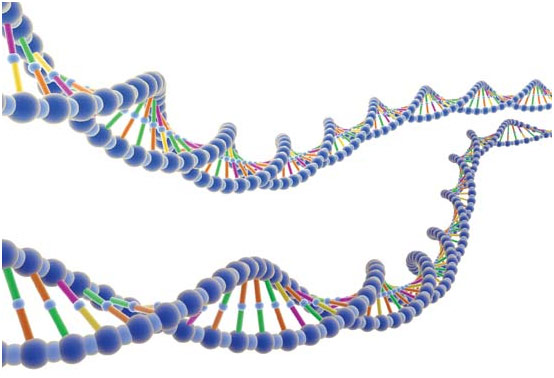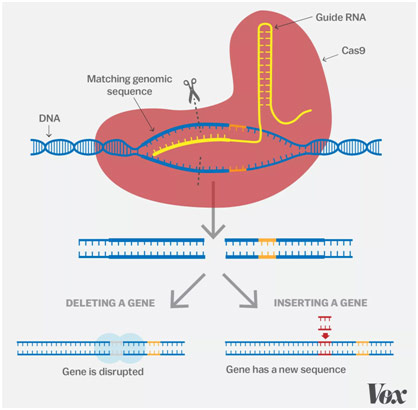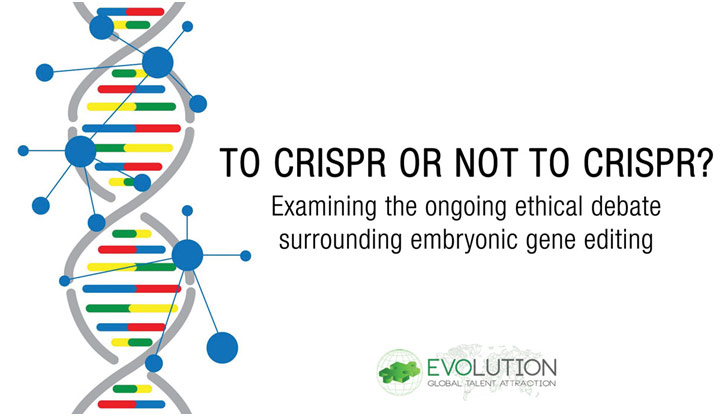CRISPR is a gene-editing tool recently discovered by scientists that have enormous potential to usher in a new era of medicine. CRISPR can be used to stop diseases like cystic fibrosis and Down syndrome by editing the genome and fixing mutations in the embryo as a means of preventative medicine. Scientists can edit out unfavorable portions of DNA using CRISPR as “molecular scissors” and instead paste more favorable portions of DNA. The potential is huge in ushering a new era where doctors can cure most diseases that were thought to incurable before.

Illustration of DNA Strands
CRISPR specifically uses the Cas9 enzyme to cut the DNA. However, to get to the specific DNA that they want to cut, scientists need to make an RNA sequence that matches the respective DNA. This is where the CrispRGold Program, developed by researchers at the Max Delbrück Center for Molecular Medicine, comes in. The program basically looks through a DNA sequence, finds out the optimal place to make the cut, and suggests a sgRNA (single guide RNA) sequence that will send the Cas9 enzyme only to that exact region needing the cut. Now, I will talk about two major experiments concerning CRISPR in recent times. The first was done by researchers at the Salk Institute in California, reversing blindness in mice. The blindness in these mice was retinitis pigmentosa, which is a genetic and degenerative condition where retinal cells slowly breakdown, causing blindness. Researchers were able to edit the faulty gene out and replace it with a healthy replacement for the three-week-old blind mice. Only a mere five weeks later, the mice were able to respond to light, demonstrating that their eyes were healing. In a separate experiment, researchers from Oregon Health and Science University removed faulty genes that cause a certain type of heart disease from embryos. The heart disease was specifically hypertrophic cardiomyopathy, which is when the heart muscles become enlarged, and it can cause a variety of other complications such as putting people into cardiac arrest. In this study, they took eggs from healthy women and fertilized them with sperm from a carrier of the mutation that causes hypertrophic cardiomyopathy. In this case, they simply just cut out the faulty part and let the embryo repair the region itself with the other copy of genes from the maternal parent who did not have the mutation. Surprisingly, it was successful in almost three-fourths of the embryos, which shows that CRISPR is extremely promising in reversing a variety of genetic disorders.

How CRISPR Works
While CRISPR holds extreme potential, there are many practical and ethical concerns that need to be addressed. The major practical concern basically asks if CRISPR does more harm than good. In the experiment done by the Salk Institute that I mentioned before, it was found that there were a lot of accidental mutations caused when trying to delete and insert the gene responsible for retinitis pigmentosa. Specifically, there were more than 1500 accidental genetic changes per mouse. However, some scientists have claimed that they used “unusual methods” when editing the mouse’s’ DNA, resulting in too much Cas9 enzyme being added. An ethical concern that seems extremely valid to me at least is to what extent can CRISPR be used and to what extent will it be used. Some fear that CRISPR could be used in the future to create “designer babies” with parents checking off the perfect traits they want in their baby instead of solely being used for noble purposes like getting rid of genetic diseases. For example, some imagine a world where CRISPR becomes increasingly commercialized with parents paying for their future child to be athletic, to be super smart, or to be musically talented to name a few. Another sub-point of this concern is that only the wealthy may be able to afford these genetic edits that give them an edge over others who are less fortunate, eventually fostering more inequality in the world. However, many scientists say that this worry is not realistic for now since there are many different traits and genes that determine each of these characteristics, so editing them to create the ideal child is impossible as of right now. Many realize that there will eventually need to be laws in place to set standards on what can and what cannot do be done in regards to gene editing.

Ethical Debate Concerning CRISPR
CRISPR has enormous potential to revolutionize medicine in ways that we can only dream of. Diseases could be prevented before they cause any problem, saving millions and even billions of lives in the long run. With these practical and ethical concerns in mind, experimentation should continue to improve the technology and to see if it is viable as a mass-market tool to eradicate genetic diseases. We could see many more clinical trials within the next decade, and it is reasonable to think that they will be successful in treating patients.
References
Barclay, Eliza. “Scientists Successfully Used CRISPR to Fix a Mutation That Causes Disease. This Is Huge.” Vox, 2 Aug. 2017, vox.com/science-and-health/2017/8/2/16083300/crispr-heart-disease. Accessed 19 Aug. 2017.
“CRISPR Controversy Raises Questions about Gene-editing Technique.” The Conversation, 31 May 2017, theconversation.com/crispr-controversy-raises-questions-about-gene-editing-technique-78638. Accessed 19 Aug. 2017.
Devlin, Hannah. “Breakthrough as Gene-editing Technique Restores Sight to Blind Animals.” The Guardian, 16 Nov. 2016, theguardian.com/science/2016/nov/16/breakthrough-as-gene-editing-technique-restores-sight-to-blind-animals. Accessed 19 Aug. 2017.
DNA. Encyclopedia Brittanica, britannica.com/science/DNA. Accessed 19 Aug. 2017.
“Genome Editing: Efficient CRISPR Experiments in Mouse Cells.” Phys Org, 25 Oct. 2016, phys.org/news/2016-10-genome-efficient-crispr-mouse-cells.html. Accessed 19 Aug. 2017.
To CRISPR or Not to CRISPR? Evolution, evobiotalent.com/news-analysis/to-crispr-or-not-to-crispr-the-ongoing-ethical-debate-surrounding-embryonic-gene-editing/.
Strong stuff – CRISPR/CAS9. Pinterest, pinterest.com/pin/219480181818274297/. Accessed 19 Aug. 2017.
Woollaston, Victoria. “What Is CRISPR and Why Does It Have Such a Bad Reputation?” Alphr, 4 July 2017, alphr.com/bioscience/1001654/crispr-cas9-gene-editing. Accessed 19 Aug. 2017.















